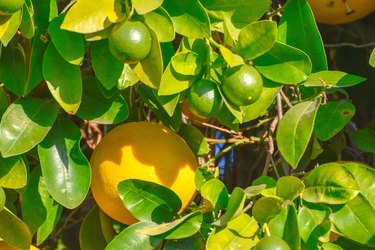
Grapefruit plants (Citrus × paradisi, USDA plant hardiness zones 9-12) produce a type of citrus fruit that can come in many colors. They're often tart, tangy or even sour. These fragrant fruits grow on large trees with beautiful, waxy green leaves, and you can even use them as home decor. Growing your grape fruit tree is challenging yet rewarding, especially when you harvest those delicious fruits. But how often does a grapefruit tree bear fruit? It's certainly not often enough if you love grapefruit!
Grapefruits have segmented fruit inside with a similar texture to other citrus fruits: juicy and pulpy. There are countless varieties of grapefruit, such as Ruby Red (Citrus x paradise 'Ruby Red,' zones 8-11), Oro Blanco (Citrus grandis × Citrus paradisi, zones 8-11), Melogold (Citrus grandis × Citrus paradisi, zones 8-11) and Star Ruby (Citrus x paradisi 'Star Ruby,' zones 9-11). They all grow approximately the same size despite their different interiors. They all have different levels of sourness, and some are even downright sweet. These tart fruits grow in tropical climates and can be found at your local grocery store year-round.
Video of the Day
Video of the Day
When Is Grapefruit Season?
Grapefruits grow well outdoors in zones 9 and up. They require warm conditions day and night and prefer temperate or tropicallike regions. Because of this, you can find them growing in California and Florida, which both have the warm environment that the grapefruit tree needs.
A grapefruit tree will bear fruit once per season if grown in optimal conditions. When planting your grapefruit tree, you should know that in the first few years, your tree may grow fruit, but it isn't until the third year that the fruit becomes edible. You should remove any fruit it produces before year three because this will allow the tree to focus its energy on growth rather than fruit production. Wait until the fall months to try to harvest the first bounty. Generally, you can harvest this fruit once it has turned yellow or gold. The longer you leave a grapefruit on the tree, the sweeter it will become.
Why Would a Grapefruit Not Bear Fruit?
Keep in mind that there are a number of circumstances that may cause grapefruit trees not to bear fruit. This can include the age of the tree or lack of vigor. It may also be due to cultural and environmental conditions, a late spring freeze, a pest infestation or a disease. Temperatures vary from year to year even within growing zones, so the performance of your tree in one growing season may not be consistent with its fruit bearing in the next. The flowers of fruit trees are extremely sensitive to late spring frosts, and in fact, temperatures below freezing prevent fruit formation in plants like grapefruit trees.
Grapefruit History and Types
While it may sound silly for fruit to have a history, the grapefruit has a history worth mentioning. Grapefruit was first discovered in the 1750s in Barbados. The fruit had only just started growing and is thought to have come from a cross-pollination of pomelo (Citrus maxima, zones 9-11) and a sweet orange (Citrus sinensis, zones 9-11). These two fruits were first introduced to the Americas by Spanish explorers as early as the 15th century.
Grapefruits were first planted in the United States between the 1820s and 1840s, first in the state of Florida. People at the time initially used them for their stunning foliage of bright green and glossy leaves with large yellow fruits in bunches. After the trend took off, people realized that the fruit was actually good too. Today, there are over 20 varieties of grapefruit growing from Florida to California and even Arizona and Texas.
Grapefruit Health Benefits
Like its other citrus relatives, grapefruit is an excellent addition to a well-balanced diet. Most often, a serving size of grapefruit is half of the fruit, as a whole grapefruit may be too tart to eat in one sitting. Much like oranges, grapefruits have a high vitamin C content. Vitamin C has antioxidant properties that are known to shield your cells from damaging bacteria and viruses.
A study by the Department of Nutritional Studies at the University of Arizona showed that people who ate grapefruit three times a day for six weeks had significantly lower blood pressure throughout the study. They also proved modest weight loss and a more significant reduction in waist circumference after eating grapefruit.
It's important to note that grapefruit may interact with certain medications. Before starting a new medication, be sure to ask your doctor if eating grapefruit is safe while on that medication.
- University of Florida IFAS: Pummelo
- Minneopa Orchards: The Star Ruby Grapefruit Tree
- Paradise Nursery: Oroblanco Grapefruit Tree
- Fast Growing Trees: Ruby Red Grapefruit Tree
- North Carolina State Extension: Citrus x paradisi
- Wisconsin Department of Public Instruction: Grapefruit
- Healthline: 10 Science-Based Benefits of Grapefruit
- National Library of Medicine: The Effects of Daily Consumption of Grapefruit on Body Weight, Lipids, and Blood Pressure in Healthy, Overweight Adults
- Marin Independent Journal: No Fruit on Your Tree? Here's Why